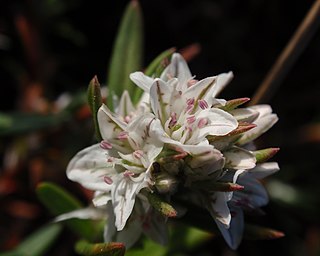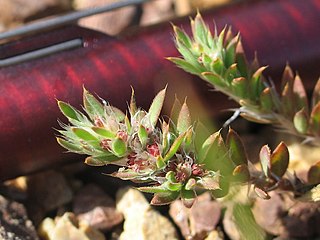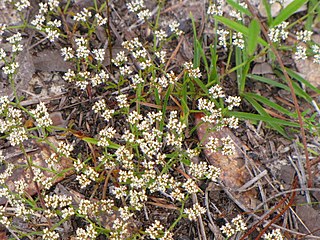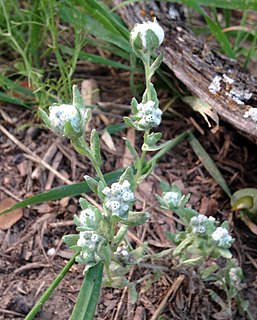
Allium drummondii, also known as Drummond's onion, wild garlic and prairie onion, is a North American species of onion native to the southern Great Plains of North America. It is found in South Dakota, Kansas, Nebraska, Colorado, Oklahoma, Arkansas, Texas, New Mexico, and northeastern Mexico.

Paronychia is a genus of plants in the family Caryophyllaceae with over 110 species worldwide, mostly from warm-temperate North America, Eurasia, South America and Africa. They are herbs that are annual or biennial or perennial in life span. Some species have a woody base. For the most part they have small, white to yellow-white colored flowers that are often hidden within the paired bracts.

Banksia drummondii, commonly known as Drummond's dryandra, is a species of shrub that is endemic to Western Australia. It has pinnatifid to pinnatisect leaves, heads of up to one hundred cream-coloured, red and yellow flowers and glabrous fruit.

Isocoma commonly called Jimmyweed or goldenweed, is a genus of North American semi-woody shrubs in the sunflower family. It is found in the semi-arid areas of Southwestern United States and Mexico.

Malvaviscus arboreus is a species of flowering plant in the hibiscus family, Malvaceae, that is native to the Southeastern United States, Mexico, Central America, and South America. The specific name, arboreus, refers to the tree-like appearance of a mature plant. It is now popular in cultivation and goes by many English names including Turkcap, Turk's turban, wax mallow, ladies teardrop and Scotchman's purse. Its flowers do not open fully and help attract butterflies and hummingbirds.

Polygonum paronychia is a species of flowering plant in the knotweed family known by the common names dune knotweed, black knotweed, and beach knotweed. It is native to the coastline of western North America from British Columbia to California, where it grows in sandy coastal habitat such as beaches, dunes, and scrub.

Sapindus saponaria is a small to medium-sized deciduous tree native to the Americas. Common names include wingleaf soapberry, western soapberry, jaboncillo, sulluku and manele and a'e (Hawaiian). Its genus name, "Sapindus", comes from the Latin, meaning Indian soap, and its specific epithet means "soapy."

Paronychia chartacea is a rare species of flowering plant in the family Caryophyllaceae known by the common names papery Whitlow-wort and paper nailwort. It is endemic to Florida in the United States. There are two subspecies of the plant; ssp. chartacea occurs in Central Florida, especially the Lake Wales Ridge, and ssp. minima is native to the Florida Panhandle. The two subspecies are geographically separated and do not occur together. Both are included on the federal Endangered Species List, on which the species is designated threatened.
Dalea reverchonii is a species of flowering plant in the legume family known by the common name Comanche Peak prairie-clover. It is endemic to Texas in the United States, where it is known from Bosque, Erath, Hood, Johnson, Parker, Somervell, Tarrant, and Wise counties. This species was first collected by Julien Reverchon at the top of Comanche Peak. As of 2015 the species still grows there.

Paronychia franciscana is a species of flowering plant in the family Caryophyllaceae known by the common names San Francisco nailwort, California Whitlow-wort, Franciscan paronychia, and Chilean nailwort. It is native to Chile, but it was first described from specimens collected in San Francisco, California, in the United States, where it is an introduced species.

Paronychia rugelii, common name Rugel's nailwort, is a plant native to the US states of Georgia and Florida. It can be found in woodlands and on disturbed sites at elevations below 200 m. They are sometimes referred to as sand squares.
Paronychia argyrocoma, the silvery nailwort, is a plant species native to the eastern United States. It has a disjunct distribution, found in New England and the Appalachian Mountains of the Southeast but not from New York, New Jersey or Pennsylvania in between. The species grows on rocky sites at elevations of 200–1800 m.
Cirsium drummondii, called Drummond's thistle, dwarf thistle or short-stemmed thistle, is a North American species of plants in the thistle tribe within the sunflower family. The species is native to central and western Canada, in every province from Ontario to British Columbia, plus the Northwest Territories. In the United States, it has been found only in the Black Hills of Wyoming and South Dakota.

Diaperia verna, common names spring pygmycudweed, spring rabbit-tobacco or many-stem rabbit-tobacco, is a plant species in the sunflower family, native to northern Mexico and the southern United States.
Solidago drummondii, commonly called Drummond's goldenrod, is a North American species of flowering plants in the sunflower family. It is native to the middle Mississippi Valley of the Central United States, primarily in Missouri and Arkansas but with additional populations in Louisiana and Illinois.
Helenium drummondii is a North American perennial plant in the Sunflower Family, commonly known as fringed sneezeweed. It is native to the south- central United States, in eastern Texas, Arkansas, and Louisiana.
Xyris drummondii, common name Drummond's yelloweyed grass, is a North American species of flowering plant in the yellow-eyed-grass family. It is native to the coastal plain of the United States from Georgia to eastern Texas.

Hedeoma reverchonii, commonly called Reverchon's false pennyroyal, is a species of flowering plant in the mint family (Lamiaceae). It is native to the south central region of the United States, where it is primarily found in Texas, extending into small areas of Arkansas and Oklahoma. Its natural habitat is on open, calcareous rock outcrops.

Alophia drummondii, commonly called propeller flower, is a species of flowering plant in the family Iridaceae. It is native to the North and South America, where it ranges from the U.S. states of Arkansas and Oklahoma southward into Mexico. There is also an apparent disjunct population in Paraguay.

Symphyotrichum drummondii is a species of flowering plant of the aster family (Asteraceae) native to eastern and central North America. Commonly known as Drummond's aster, it is a perennial, herbaceous plant that may reach 120 centimetres high. Each flower head has many tiny florets put together into what appear as one.














